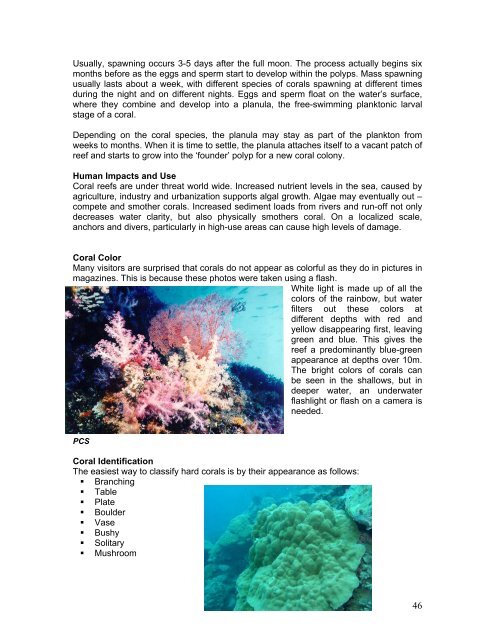KOROR STATE GOVERNMENT MARINE TOUR GUIDE ... - C3
KOROR STATE GOVERNMENT MARINE TOUR GUIDE ... - C3
KOROR STATE GOVERNMENT MARINE TOUR GUIDE ... - C3
You also want an ePaper? Increase the reach of your titles
YUMPU automatically turns print PDFs into web optimized ePapers that Google loves.
Usually, spawning occurs 3-5 days after the full moon. The process actually begins six<br />
months before as the eggs and sperm start to develop within the polyps. Mass spawning<br />
usually lasts about a week, with different species of corals spawning at different times<br />
during the night and on different nights. Eggs and sperm float on the water’s surface,<br />
where they combine and develop into a planula, the free-swimming planktonic larval<br />
stage of a coral.<br />
Depending on the coral species, the planula may stay as part of the plankton from<br />
weeks to months. When it is time to settle, the planula attaches itself to a vacant patch of<br />
reef and starts to grow into the ‘founder’ polyp for a new coral colony.<br />
Human Impacts and Use<br />
Coral reefs are under threat world wide. Increased nutrient levels in the sea, caused by<br />
agriculture, industry and urbanization supports algal growth. Algae may eventually out –<br />
compete and smother corals. Increased sediment loads from rivers and run-off not only<br />
decreases water clarity, but also physically smothers coral. On a localized scale,<br />
anchors and divers, particularly in high-use areas can cause high levels of damage.<br />
Coral Color<br />
Many visitors are surprised that corals do not appear as colorful as they do in pictures in<br />
magazines. This is because these photos were taken using a flash.<br />
White light is made up of all the<br />
colors of the rainbow, but water<br />
filters out these colors at<br />
different depths with red and<br />
yellow disappearing first, leaving<br />
green and blue. This gives the<br />
reef a predominantly blue-green<br />
appearance at depths over 10m.<br />
The bright colors of corals can<br />
be seen in the shallows, but in<br />
deeper water, an underwater<br />
flashlight or flash on a camera is<br />
needed.<br />
PCS<br />
Coral Identification<br />
The easiest way to classify hard corals is by their appearance as follows:<br />
• Branching<br />
• Table<br />
• Plate<br />
• Boulder<br />
• Vase<br />
• Bushy<br />
• Solitary<br />
• Mushroom<br />
46











